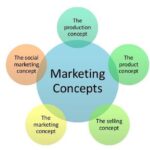Objectives
In this lesson, we will introduce you to the activities that makeup the marketing process. After you work out this lesson, you should be able to:
· Identify the parts of the marketing process
· Understand the relationships among the parts of the marketing process
· Explain how the marketing process creates, captures and sustains value for the customer
In this lesson, we will discuss the following:
· Formulation of marketing strategy
· Marketing planning
· Marketing programming, allocating and budgeting
· Marketing implementation
· Monitoring and auditing
· Analysis and research
· Schematic of marketing process
Introduction
While there is lot of focus on the substance of marketing, particularly the marketing mix, an equally important aspect of marketing is the marketing process – how marketers do their job. The process is equal in importance to the substance because the process determines the nature and quality of the decisions made. A good process is likely to lead to a good decision. On the other hand, a faulty process will produce a good decision only on a random or accidental basis.
The marketing process can be divided in several different ways. One popular conceptualization of marketing tasks is:
1. Strategy formulation – the development of the broadest marketing/business strategies with the longest-term impact
2. Marketing planning – the development of longer-term plans which have generally stronger impact than the short-term programs
3. Marketing programming, allocating and budgeting – the development of short-term programs which generally focus on integrated approaches for a given product and on the allocation of scarce resources such as sales effort or product development time across various products and functions
4. Marketing implementation – the actual task of getting the marketing job done
5. Monitoring and auditing – the review and analysis of programs, plans and strategies to assess their success and to determine what changes must be made
6. Analysis and research – the deliberate and careful acquisition and examination of qualitative and quantitative data to improve decision making .
Though implied and considered as part of the overall corporate planning, the importance of situation analysis can never be undermined during marketing strategy formulation. Especially under product policies, but throughout the marketing mix elements, the company, customer and competitive scanning is so essential to marketing success. Situation analysis describes the process by which environmental assessment, marketing research and market size/growth estimates get done. It pays particular attention to environment scanning skills useful in forecasting and modelling consumer behaviour.
It is important to note that each part of the process is intimately related to the other parts of the process. Figure 1.3.1 is an attempt to capture the more important relationships. The dividing lines between any two parts of the process are vague and unclear. This is particularly true of those elements of the processes which are clearly connected. For example, the distinction between a marketing plan and a marketing program is very unclear for many. But the precise boundaries are not as important as the general concept. Each element can be divided into smaller sub elements. For example, marketing planning includes market assessment which is the evaluation and selection to serve specific customer markets. Product line planning is another sub element of marketing planning.
Figure Relationships among the six parts of the marketing process

Formulation of marketing strategy
Strategy formulation is the broadest, longest-term marketing activity. At this stage, complex and subtle integration with other corporate functions is required. All of the functional strategies must fit together into a business strategy. Because marketing deals with customers and the competitive environment, it is an early part of the total strategy formulation process. When done well, it is impossible to separate the marketing strategy from the corporate strategy. The two meld into a unified whole.
The strategic process is one of working with market dynamics (a particular segment or selection of the market) to achieve a solid positioning of the product/service offering that contains a clear ‘benefit promise’ to the consumer which is differentiable from the offers of the competition and which thus positions the firm well for potential competitive responses to its actions.


